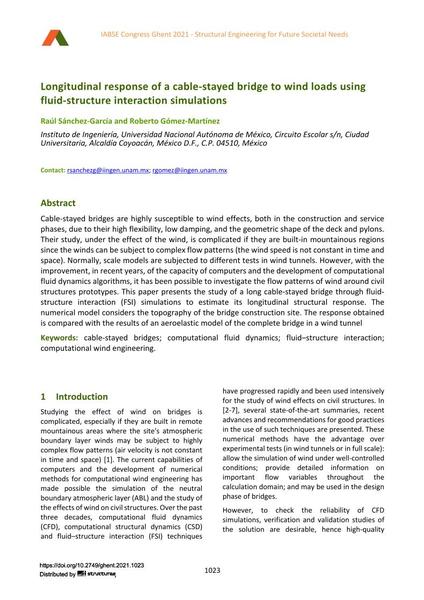Longitudinal response of a cable-stayed bridge to wind loads using fluid-structure interaction simulations

|
|
|||||||||||
Bibliographic Details
| Author(s): |
Raúl Sánchez-García
(Instituto de Ingeniería, Universidad Nacional Autónoma de México, Circuito Escolar s/n, Ciudad Universitaria, Alcaldía Coyoacán, México D.F., C.P. 04510, México)
Roberto Gómez-Martínez (Instituto de Ingeniería, Universidad Nacional Autónoma de México, Circuito Escolar s/n, Ciudad Universitaria, Alcaldía Coyoacán, México D.F., C.P. 04510, México) |
||||
|---|---|---|---|---|---|
| Medium: | conference paper | ||||
| Language(s): | English | ||||
| Conference: | IABSE Congress: Structural Engineering for Future Societal Needs, Ghent, Belgium, 22-24 September 2021 | ||||
| Published in: | IABSE Congress Ghent 2021 | ||||
|
|||||
| Page(s): | 1023-1030 | ||||
| Total no. of pages: | 8 | ||||
| DOI: | 10.2749/ghent.2021.1023 | ||||
| Abstract: |
Cable-stayed bridges are highly susceptible to wind effects, both in the construction and service phases, due to their high flexibility, low damping, and the geometric shape of the deck and pylons. Their study, under the effect of the wind, is complicated if they are built-in mountainous regions since the winds can be subject to complex flow patterns (the wind speed is not constant in time and space). Normally, scale models are subjected to different tests in wind tunnels. However, with the improvement, in recent years, of the capacity of computers and the development of computational fluid dynamics algorithms, it has been possible to investigate the flow patterns of wind around civil structures prototypes. This paper presents the study of a long cable-stayed bridge through fluid- structure interaction (FSI) simulations to estimate its longitudinal structural response. The numerical model considers the topography of the bridge construction site. The response obtained is compared with the results of an aeroelastic model of the complete bridge in a wind tunnel |
||||
| Keywords: |
cable-stayed bridges Computational Fluid Dynamics computational wind engineering fluid–structure interaction
|
||||
| Copyright: | © 2021 International Association for Bridge and Structural Engineering (IABSE) | ||||
| License: | This creative work is copyrighted material and may not be used without explicit approval by the author and/or copyright owner. |
||||

